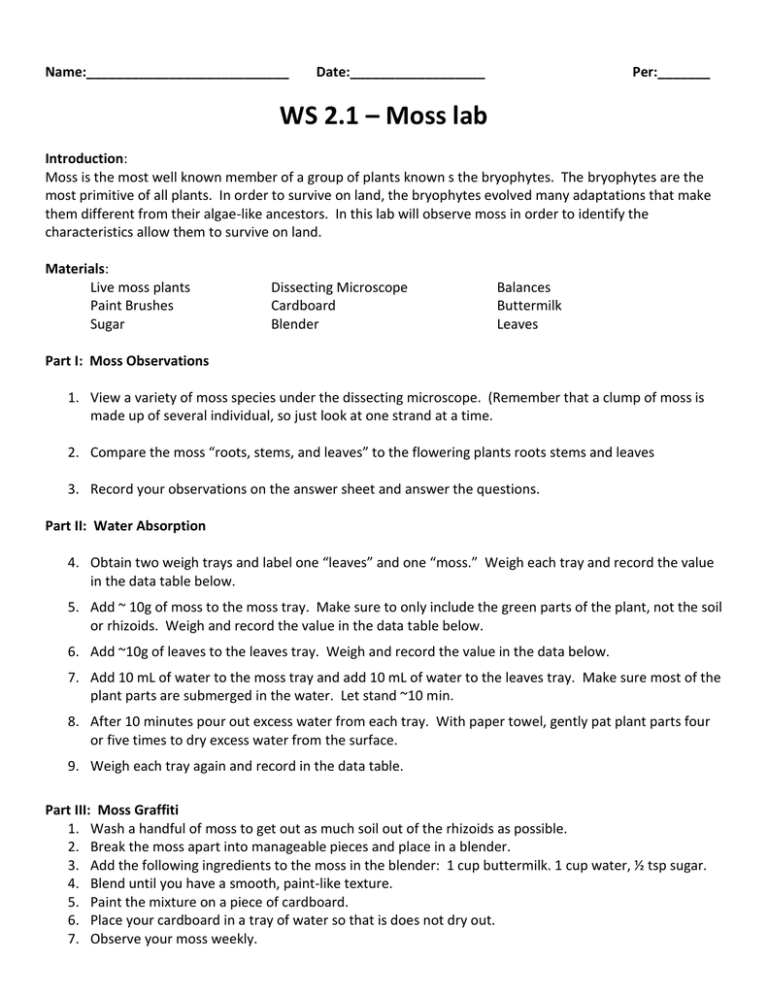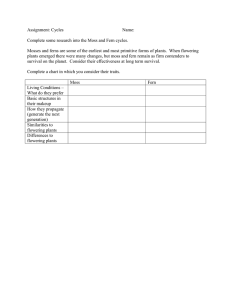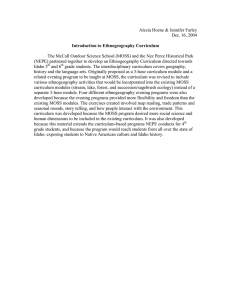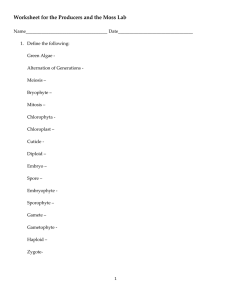WS 2.1 – Moss lab
advertisement

Name:___________________________ Date:__________________ Per:_______ WS 2.1 – Moss lab Introduction: Moss is the most well known member of a group of plants known s the bryophytes. The bryophytes are the most primitive of all plants. In order to survive on land, the bryophytes evolved many adaptations that make them different from their algae-like ancestors. In this lab will observe moss in order to identify the characteristics allow them to survive on land. Materials: Live moss plants Paint Brushes Sugar Dissecting Microscope Cardboard Blender Balances Buttermilk Leaves Part I: Moss Observations 1. View a variety of moss species under the dissecting microscope. (Remember that a clump of moss is made up of several individual, so just look at one strand at a time. 2. Compare the moss “roots, stems, and leaves” to the flowering plants roots stems and leaves 3. Record your observations on the answer sheet and answer the questions. Part II: Water Absorption 4. Obtain two weigh trays and label one “leaves” and one “moss.” Weigh each tray and record the value in the data table below. 5. Add ~ 10g of moss to the moss tray. Make sure to only include the green parts of the plant, not the soil or rhizoids. Weigh and record the value in the data table below. 6. Add ~10g of leaves to the leaves tray. Weigh and record the value in the data below. 7. Add 10 mL of water to the moss tray and add 10 mL of water to the leaves tray. Make sure most of the plant parts are submerged in the water. Let stand ~10 min. 8. After 10 minutes pour out excess water from each tray. With paper towel, gently pat plant parts four or five times to dry excess water from the surface. 9. Weigh each tray again and record in the data table. Part III: Moss Graffiti 1. Wash a handful of moss to get out as much soil out of the rhizoids as possible. 2. Break the moss apart into manageable pieces and place in a blender. 3. Add the following ingredients to the moss in the blender: 1 cup buttermilk. 1 cup water, ½ tsp sugar. 4. Blend until you have a smooth, paint-like texture. 5. Paint the mixture on a piece of cardboard. 6. Place your cardboard in a tray of water so that is does not dry out. 7. Observe your moss weekly. Part I: Comparison of moss to flowering plant 1. What was the difference between the moss roots and the flowering plant roots? 2. What was the difference between the moss stems and the flowering plant stems? 3. Did you observe veins running through the leaf-like structures moss plant? Yes or No 4. Combine your answer from the questions above to determine the characteristics differentiate moss from other groups of plants (ferns, cone plants and flowering plants ) Part II: Water Absorption 5. Complete the table. Initial Weight of Plant Final Weight Weight of Water Absorbed % Absorbed Water Moss Vascular Leaves 6. Which plant absorbed more water? Moss or broad leaf plant 7. What organ absorbs water for a flowering plants? 8. What tissue on leaves prevents them from absorbing water? 9. How do mosses absorb most of their water? 10. Do mosses have a cuticle on their leaves? 11. What does the above information indicate about the environments moss can and can’t thrive in?






